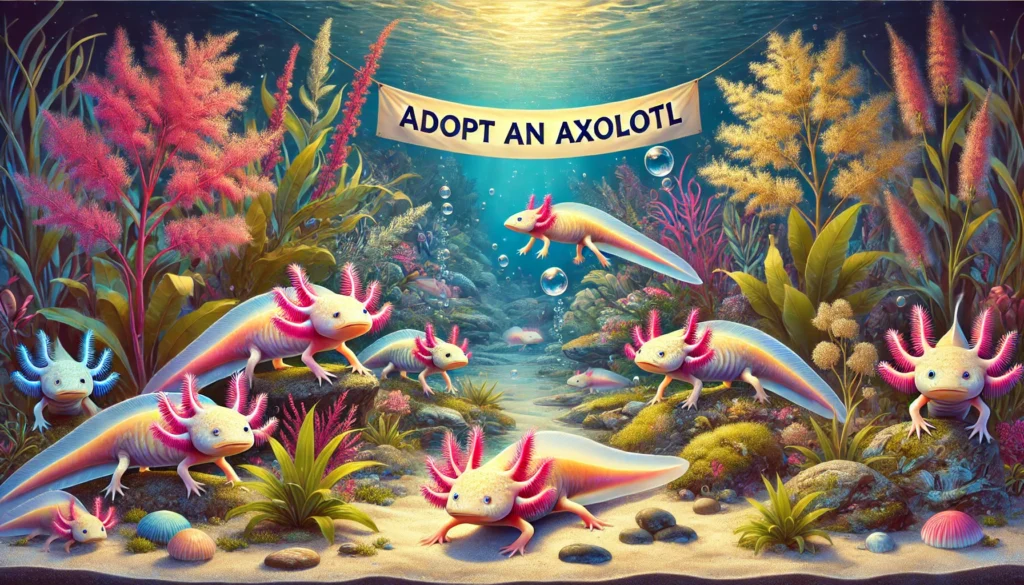If you’re looking to adopt axolotl, you’re about to embark on a journey with one of the most unique and captivating pets out there. Known for their adorable “smiles” and extraordinary ability to regenerate limbs, axolotls are aquatic creatures that make great companions for the right pet owner. This guide will walk you through everything you need to know about how to adopt axolotl and provide them with the care they deserve.
Why Adopt Axolotl?
Axolotls are not your average pet, and that’s what makes them so special. Here’s why so many people choose to adopt axolotl:
- Unique Appearance: With their feathery gills and “grinning” faces, axolotls are unlike any other pet.
- Quiet and Calm: Axolotls are silent and thrive in calm environments, making them ideal for low-noise households.
- Long Lifespan: With proper care, axolotls can live for 10–15 years, offering years of companionship.
Before You Adopt Axolotl: Are You Ready?
Adopting an axolotl is a long-term commitment. Here’s what to consider:
- Research Their Needs: Axolotls require specific water conditions, a suitable diet, and a proper tank setup.
- Check Local Laws: In some areas, owning axolotls is restricted or requires a permit, so confirm the regulations where you live.
- Commitment: Axolotls live a long time, and their care is ongoing. Make sure you’re ready for this responsibility before you adopt axolotl.
Setting Up the Ideal Habitat
Creating the perfect home for your axolotl is key to their health and happiness. Here’s how:
Tank Size and Setup:
A 20-gallon tank is the minimum for one axolotl; add 10 gallons for each additional one.
Use a low-flow filter to keep the water clean without stressing your axolotl.
Water Conditions:
Maintain the temperature between 60–68°F (16–20°C).
Regularly test the water for ammonia, nitrites, and nitrates, and aim for a pH level of 6.5–7.5.
Substrate:
Avoid gravel, as axolotls can swallow it, leading to health issues. Opt for fine sand or a bare-bottom tank.
Decor and Hiding Spots:
Add caves, plants, or hides to make your axolotl feel secure.
Avoid sharp or rough decorations that might injure their delicate skin.
What Do Axolotls Eat?
Once you adopt axolotl, providing the right diet is essential. Axolotls are carnivorous and thrive on a high-protein diet. Here’s what you can feed them:
- Staple Foods: Bloodworms, brine shrimp, and axolotl-specific pellets.
- Treats: Occasionally, you can offer earthworms or small feeder fish.
- Feeding Schedule: Feed adults every 2–3 days and juveniles daily.
Finding Your Axolotl: Where to Adopt Axolotl
When deciding where to adopt axolotl, choose a reputable and ethical source. Here are your options:
- Breeders: Look for breeders who prioritize the health and well-being of their axolotls.
- Pet Stores: Check the axolotl’s health and environment before purchasing.
- Rescues: Adopting from a rescue is a great way to provide a home to an axolotl in need.
Signs of a healthy axolotl include:
- Clear eyes and skin.
- Feathery, vibrant gills.
- Calm but active behavior.
Caring for Your Axolotl After Adoption
Once you adopt axolotl, ongoing care is crucial:
- Handling: Minimize handling as their skin is delicate and absorbs substances from the water.
- Tank Maintenance: Perform weekly water changes of 20–30% to keep the environment clean.
- Health Monitoring:
- Watch for signs of stress, such as curled tails or loss of appetite.
- Look out for fungal infections on their gills, which appear as white patches.
Common Myths About Axolotls
Let’s clear up some common misconceptions:
- Myth 1: Axolotls are difficult to care for.
- Reality: They’re easy to care for if their specific needs are met.
- Myth 2: Axolotls can live with other fish.
- Reality: Fish often nip at axolotls’ gills, so it’s best to keep them alone or with other axolotls.
Conclusion
Choosing to adopt axolotl is a rewarding experience for those prepared to meet their needs. These fascinating creatures will bring joy and wonder to your life while teaching you about the beauty of aquatic ecosystems. By setting up the perfect habitat and providing proper care, you’ll ensure your axolotl thrives for years to come.
Frequently Asked Questions (FAQs)
What do I need to know before I adopt axolotl?
Before you adopt axolotl, ensure you have a suitable tank setup with a minimum of 20 gallons, proper water filtration, and a diet plan. Research their specific care needs and check local laws regarding axolotl ownership.
What do axolotls eat?
Axolotls are carnivorous and thrive on a diet of bloodworms, brine shrimp, and axolotl pellets. You can occasionally treat them with earthworms or small feeder fish. Feed adults every 2–3 days and juveniles daily.
Can axolotls live with other fish?
No, it’s not recommended to house axolotls with fish. Many fish species may nip at their delicate gills, causing stress and injury. Axolotls are best kept alone or with other axolotls of similar size.
How long do axolotls live?
Axolotls can live 10–15 years with proper care, including maintaining ideal water conditions, feeding them a nutritious diet, and providing a safe environment.
Where can I adopt axolotl?
You can adopt axolotl from reputable breeders, specialized pet stores, or rescue organizations. Always choose a healthy axolotl with vibrant gills, clear skin, and calm yet active behavior.
Recommended Article:
Adopt a Shark – A Meaningful Way to Support Shark Conservation


